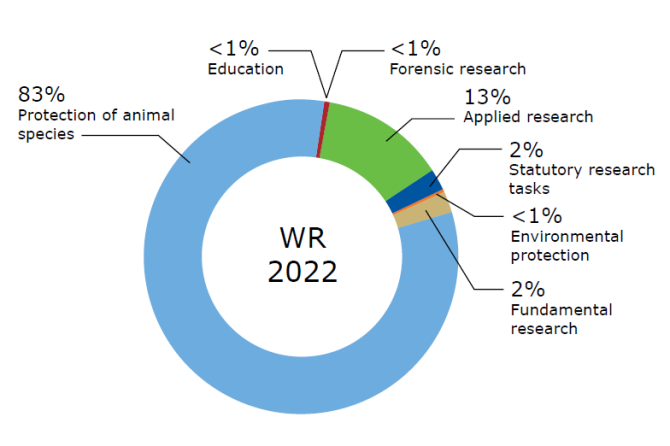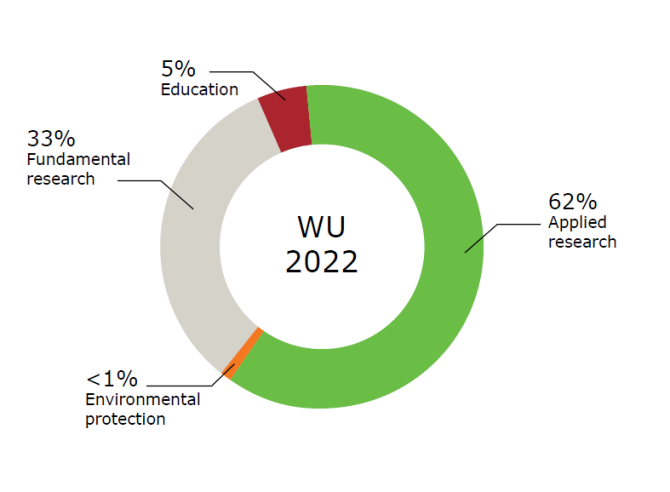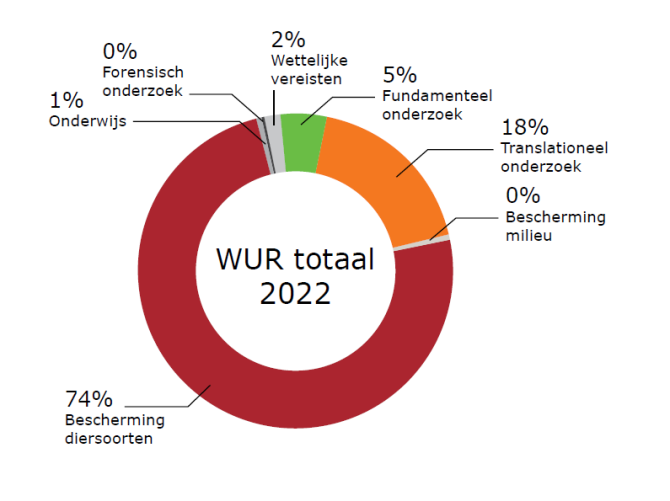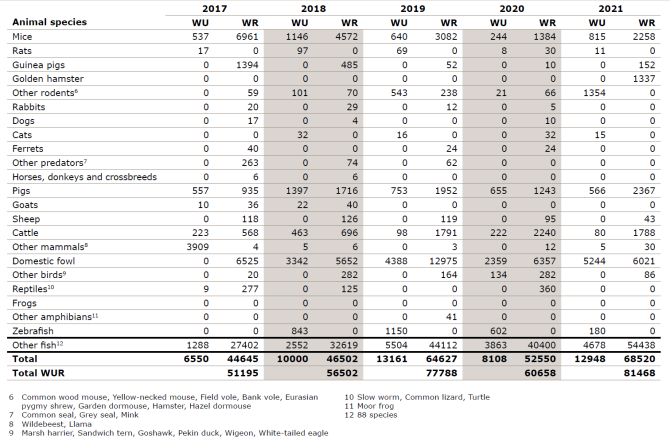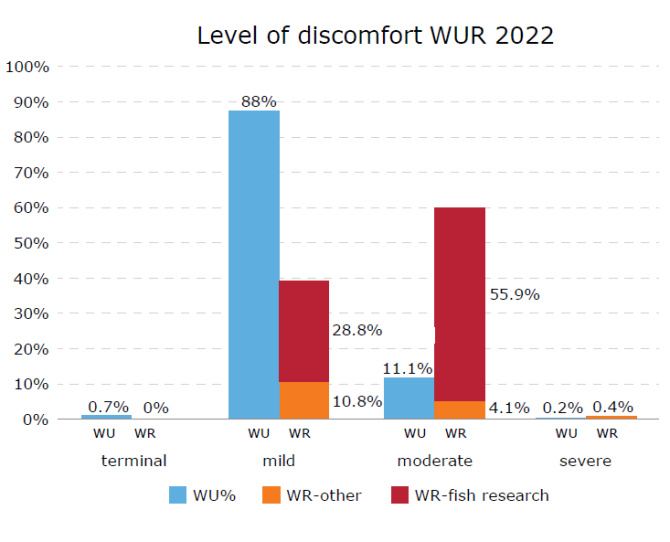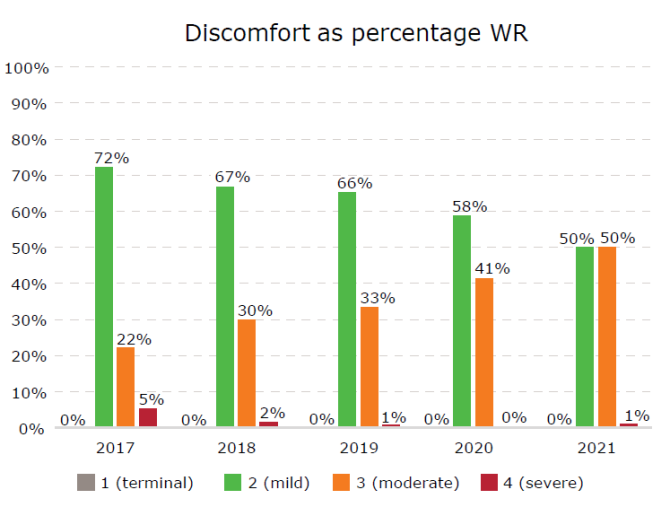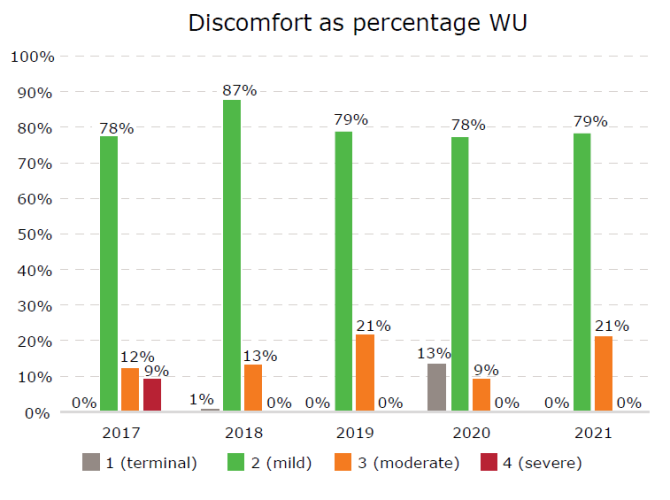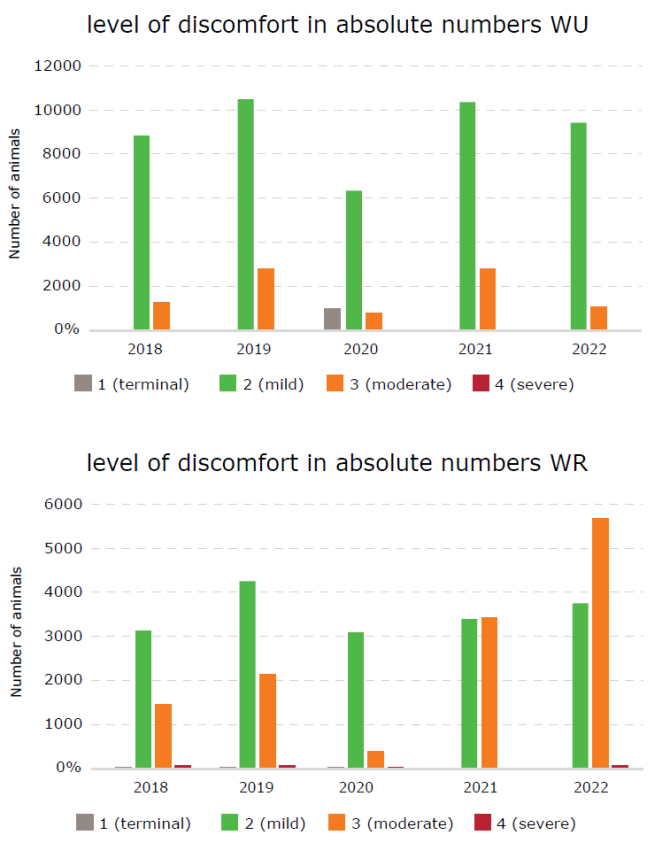
How many animal tests does WUR carry out?
A total of 104,891 animal tests were carried out at WUR in 2022, an increase of 29% compared with 2021. This increase is attributed to the increase in the number of test animals used at Wageningen Research (from 68520 to 94198) for the purpose of protecting animal species such as glass eels. More details are given on this below.
All experiments listed below are covered by the Experiments on Animals Act (Wet op dierproeven, Wod) and were completed by 2022. The number of animal experiments is not the same as the number of test animals used, because more than one experiment may be carried out on a single animal. The number of test animals used is therefore always less than the total number of animal experiments.
In 2022, 80% of all animal testing at WUR involved fish. This mainly concerned monitoring fish stocks and falls under the theme "protection of animal species". In second position are chickens (domestic fowl 12.9%) and in third mice (3.1%). Most chickens were used for animal welfare research. Not all animals in the overviews below are kept in WUR's facilities. Research for conservation or monitoring of wild populations can only be done with animals in the wild. And occasional animal experiments are carried out at practical farms.
Wageningen Research (WR)

Wageningen University (WU)
The number of test animals at WU fell from 12948 to 10693. That is a 17% decrease. This decrease applies to a variety of animal species: pigs, rodents and fish. Most of the animal tests carried out at WU in 2022 were for Applied and translational research (62%), in particular research into animal welfare. This relates to the target animal research mentioned earlier in this report. Examples include tests on food additives for chickens, to improve their gut health and overall health. This was followed by fundamental research (33%), in particular research into the immune system and animal behaviour. Education was third (5%).

Wageningen University & Research (WUR)
Animal species

Which animals are covered by the Wod?
Level of discomfort in animal testing at WUR
The table shows the level of discomfort experienced by test animals during animal testing at WUR in 2022. An expected level of discomfort is estimated as part of the project plan, with a final assessment afterwards. The table shows the actual levels of discomfort. Various factors are taken into account to determine this, such as the pain and fear that a particular procedure causes, or lasting harm to the animal.
What does discomfort mean?
Animal discomfort is assessed cumulatively. Sometimes different treatments are carried out within a single procedure, with each causing ‘mild discomfort’. But because all the treatments throughout the procedure are taken into account, the entire procedure may then fall into the ‘moderate discomfort’ category, for example.
Animal tests are assessed as terminal if the animal is killed to examine tissues or organs without undergoing any prior treatments. The animal does not therefore experience pain or discomfort during a procedure.
Mild discomfort means that there is a risk of slight pain or discomfort for a short period. These activities and procedures do not therefore significantly affect the animal’s well-being. These could include the administration of and waking from a light sedation, taking a blood sample, or administering a substance through a tube. Brief solitary confinement of social animal species such as mice or chickens is also counted as mild discomfort.
With moderate discomfort, there is a risk that the animal briefly experiences a moderate level of discomfort, or mild discomfort for a longer time. Examples of procedures that cause moderate discomfort are frequently taking blood samples, surgery with good post-operative pain management, or a number of days (depending on the species) of solitary confinement of social animals.
Severe discomfort is the highest category of discomfort. The animal is likely to experience severe discomfort during a test, to the extent that it would seriously harm the animal’s well-being. Examples of procedures that cause severe discomfort are exposure to a deadly disease associated with prolonged pain and discomfort, or keeping a social species in solitary confinement for long period of time (several weeks).
WU and WR
These tables show that the percentage of research with moderate discomfort increased at WR, but decreased at WU. The increase in the percentage of moderate discomfort at WR in 2022 compared to previous years is due to the nature of the research into fish stocks conducted at WR. Research into animal diseases, which in some cases involves infecting animals with pathogens to then study the disease, also causes moderate discomfort.
The increase in the percentage of moderate discomfort indicates a failure to achieve the intended refinement in the research. Moderate discomfort is mainly experienced as part of fish stock monitoring research.
The discomfort experienced by test animals in research conducted by WU has decreased compared to previous years: there is a higher percentage of mild discomfort and a lower percentage of moderate discomfort. This indicates a successful response to the aim of refining the research.
Compared to the national average, WU conducts a relatively large number of animal tests characterised by mild discomfort: 57.8% nationwide (2021 figures) compared to 88% at WU (2022 figures, in 2021 this was 79%).
The national average for moderate discomfort in 2021 was 35.6% while at WU it was 11.1% in 2022 (and 21% in 2021).
About half of the number of test animals used at WU are chickens (domestic fowl). Almost all research on chickens relates to animal welfare research and involves mild discomfort.
The majority (79%) of animals at WU experience mild discomfort. At WR, 50% of animals in 2022 experienced mild discomfort and 50% experienced moderate discomfort.
